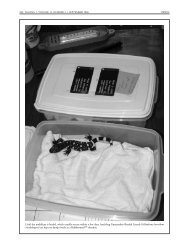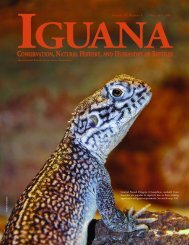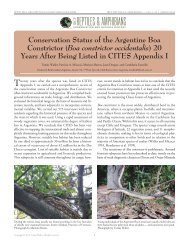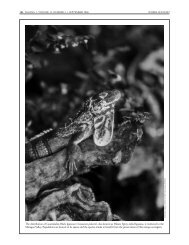Spiny-tailed Iguanas (Ctenosaura similis) in Venezuela
Spiny-tailed Iguanas (Ctenosaura similis) in Venezuela
Spiny-tailed Iguanas (Ctenosaura similis) in Venezuela
You also want an ePaper? Increase the reach of your titles
YUMPU automatically turns print PDFs into web optimized ePapers that Google loves.
180 IGUANA • VOLUME 15, NUMBER 3 • SEPTEMBER 2008 NATURAL HISTORY REPORTS<br />
The Antiguan Ground Lizard, Ameiva griswoldi,<br />
affected habitat use and abundance of<br />
Anolis wattsi on small islands near Antigua.<br />
snakes of the genus Leptotyphlops from<br />
the Lesser Antilles: One from Sa<strong>in</strong>t Lucia<br />
(L. breuili) and the other from Barbados<br />
(L. carlae). The species from Barbados is<br />
the world’s smallest snake, with a total<br />
adult length of approximately 100 mm.<br />
Limited evidence <strong>in</strong>dicates a clutch size<br />
of one and a greatly elongated egg shape.<br />
Comparison of egg shapes <strong>in</strong> snakes <strong>in</strong>dicates<br />
that the shape is a packag<strong>in</strong>g phenomenon,<br />
related primarily to the shape<br />
of the available body cavity and clutch<br />
size. The body shape of snakes also varies<br />
and <strong>in</strong>fluences the shape of snake eggs.<br />
The smallest snakes are typically stoutbodied,<br />
whereas the longest snakes usually<br />
are more slender. The allometry of<br />
organ size also affects clutch size and<br />
shape, because the smallest snakes have<br />
the smallest proportion of body cavity<br />
space available for reproduction. The best<br />
explanation for the observation of body<br />
size extremes on islands is that coloniz<strong>in</strong>g<br />
species have adapted to open ecological<br />
niches that would otherwise be occupied<br />
on the ma<strong>in</strong>land. Island colonists<br />
encounter novel environments and<br />
reduced <strong>in</strong>terspecific competition, allow<strong>in</strong>g<br />
species to evolve physical traits,<br />
<strong>in</strong>clud<strong>in</strong>g extremes <strong>in</strong> size, not normally<br />
seen on cont<strong>in</strong>ents. However, the lower<br />
limit of adult size appears to be constra<strong>in</strong>ed<br />
by the allometry of morphology,<br />
physiology, and reproduction. The smallest<br />
tetrapods have small clutches, usually<br />
one egg or young, and offspr<strong>in</strong>g that are<br />
relatively large. In the smallest snakes,<br />
offspr<strong>in</strong>g are one-half of the length of<br />
adults, compared with 10% adult length<br />
<strong>in</strong> the case of large species of snakes.<br />
Thus the evolutionary tradeoff between<br />
number and size of offspr<strong>in</strong>g appears to<br />
have reached a size boundary <strong>in</strong> these<br />
JENNIFER DALTRY<br />
species, limit<strong>in</strong>g the evolution of yet<br />
smaller species.<br />
Niche Relationships and<br />
Interspecific Interactions <strong>in</strong><br />
Antiguan Lizard Communities<br />
Anolis lizards are the focus of most<br />
Caribbean lizard community ecology<br />
studies, with few studies <strong>in</strong>clud<strong>in</strong>g other<br />
common species that might <strong>in</strong>fluence<br />
community structure. To study niche<br />
relationships and <strong>in</strong>terspecific <strong>in</strong>teractions<br />
<strong>in</strong> Antiguan lizard communities,<br />
KOLBE ET AL. (2008. Copeia 2008:<br />
261–272) used five offshore islands with<br />
vary<strong>in</strong>g comb<strong>in</strong>ations of three diurnal<br />
lizards: Ameiva griswoldi, Anolis leachii,<br />
and Anolis wattsi. The authors collected<br />
data on perch height, substrate, thermal<br />
microhabitat, body size, head length,<br />
daily activity, and abundance to characterize<br />
the ecological niche of each species.<br />
Ameiva griswoldi was more similar to A.<br />
leachii <strong>in</strong> size and daily activity, but more<br />
similar to A. wattsi <strong>in</strong> perch height, and<br />
A. leachii and A. wattsi were more similar<br />
<strong>in</strong> thermal microhabitat. This pattern of<br />
niche differentiation was consistent with<br />
niche complementarity, where species are<br />
similar on some niche axes but differ on<br />
others. Us<strong>in</strong>g the same niche characteristics<br />
as <strong>in</strong> species comparisons, we tested<br />
for a niche shift among islands for<br />
A. wattsi. In the absence of A. griswoldi,<br />
A. wattsi used lower perches, sunnier<br />
microhabitats, and was found more often<br />
on the ground. In contrast, with A.<br />
leachii absent, A. wattsi perched higher,<br />
more often <strong>in</strong> the shade, and on trunks.<br />
Furthermore, A. wattsi was most abundant<br />
when with A. leachii only, but least<br />
abundant when alone with A. griswoldi.<br />
These results suggest <strong>in</strong>terspecific <strong>in</strong>teractions,<br />
most likely due to competition<br />
and <strong>in</strong>traguild predation, are important<br />
for structur<strong>in</strong>g Antiguan lizard communities.<br />
The Barbuda Bank Tree Anole (Anolis<br />
leachii) also affected habitat use by smaller<br />
Anolis wattsi on Antiguan satellite islands.<br />
CARLOS A. RODRÍGUEZ GÓMEZ








